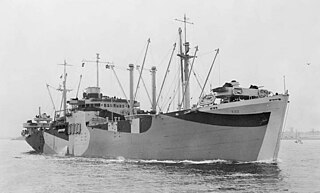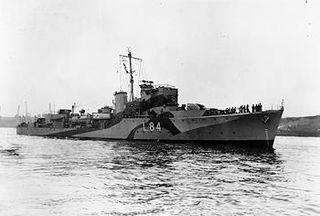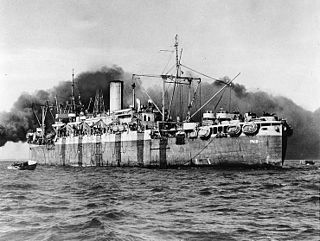
SS John W. Brown is a Liberty ship, one of two still operational and one of three preserved as museum ships. As a Liberty ship, she operated as a merchant ship of the United States Merchant Marine during World War II and later was a vocational high school training ship in New York City for many years. Now preserved, she is a museum ship and cruise ship berthed at Pier 13 in Baltimore Harbor in Maryland.

HMS Archer was a Long Island-class escort carrier built by the United States in 1939–1940 and operated by the Royal Navy during World War II. She was built as the cargo ship Mormacland, but was converted to an escort carrier and renamed HMS Archer. Her transmission was a constant cause of problems which led to her being withdrawn from front-line service. She was used as a stores ship and then as an accommodation ship before a refit and subsequent use as a merchant aircraft ferry ship, Empire Lagan.

HMS Activity was an escort carrier that served with the Royal Navy of the United Kingdom during the Second World War. After the war, she was sold into merchant service as the MV Breconshire, serving for over 20 years until scrapped in 1967.

USS Fuller (AP-14/APA-7) was a Heywood-class attack transport in service with the United States Navy from 1941 to 1946. She was scrapped in 1957.

A landing ship, infantry (LSI) or infantry landing ship was one of a number of types of British Commonwealth vessels used to transport landing craft and troops engaged in amphibious warfare during the Second World War. LSIs were operated by the Royal Navy, British Merchant Navy, Royal Canadian Navy, Royal Indian Navy, and Royal Australian Navy. They transported British Commonwealth and other Allied troops in sea assaults and invasions throughout the war.

Type C1 was a designation for cargo ships built for the United States Maritime Commission before and during World War II. Total production was 493 ships built from 1940 to 1945. The first C1 types were the smallest of the three original Maritime Commission designs, meant for shorter routes where high speed and capacity were less important. Only a handful were delivered prior to Pearl Harbor. But many C1-A and C1-B ships were already in the works and were delivered during 1942. Many were converted to military purposes including troop transports during the war.
Two ships of the Royal Navy have borne the name HMS Donovan:

HMS Hursley was a Second World War Type II Hunt-class escort destroyer of the British Royal Navy. She is the only Royal Navy ship to have carried this name. Hursley is a village in Hampshire. Commissioned in 1942, she served in the Mediterranean, before being transferred to the Hellenic Navy in November 1943 and renamed Kriti. She took part in the landings in Sicily, Anzio, and southern France, and remained in Greek service until 1959.

SS Samuel Huntington was an American liberty ship during World War II. She was the 248th liberty ship authorized by the United States Maritime Commission and was named in honor of Samuel Huntington, a Founding Father and signer of the American Declaration of Independence. SS Samuel Huntington was launched in 1942 and sailed to ports in the Pacific, South America, Africa, and the United Kingdom. She was one of a select group of liberty ships that were outfitted to carry a limited number of either troops or prisoners of war. As part of a convoy to resupply the Allied troops at Anzio, she sank after a successful German bomb attack in January 1944.
SS Empire Javelin was an Infantry Landing Ship or "LSI (Large)" in service with the UK in the latter part of the Second World War. Launched on 25 October 1943, she was a United States Maritime Commission C1-S-AY1 subtype, one of thirteen similar ships built by Consolidated Steel Corporation.

HMS P222 was a third-batch S-class submarine built for the Royal Navy during World War II. Commissioned in 1942, the boat had an uneventful first war patrol in the Alboran Sea. She intercepted the Vichy French merchant ship SS Mitidja in July, then provided protection for an Allied convoy to Malta in Operation Pedestal the next month. The navy intended that she was to be sighted on the surface by enemy aircraft to discourage potential attacks by surface warships. Though P222 did not encounter enemy forces, the convoy arrived at its destination on 15 August after sustaining severe losses. She then reconnoitred along the coast of Algeria in advance of Operation Torch, and was attacked by a French patrol ship, but sustained no damage.

USS Lamar (APA-47) was a Bayfield-class attack transport in service with the United States Navy from 1943 to 1946. She was sold into commercial service in 1948 and was scrapped in 1971.

SS President Roosevelt was an ocean liner in service in the 1920s and 1930s. Originally built as a Harris-class attack transport towards the end of World War I, she entered commercial service after her completion. Having been built as Peninsula State, she was soon renamed President Pierce and then President Roosevelt. Requisitioned for service as a troopship with the US Navy during World War II, she was renamed USS Joseph T. Dickman (APA-13) and served in the Atlantic and Pacific theaters, being scrapped postwar in 1948.

USCGC Sebago was a Lake-class cutter belonging to the United States Coast Guard launched on 12 April 1930 and commissioned on 2 October 1930. After 11 years of service with the Coast Guard, she was transferred to the Royal Navy as part of the Lend-Lease to the Allies and became HMS Walney.

HMS Sainfoin was a landing ship, infantry of the Royal Navy that was built in 1943 by Consolidated Steel Corporation, Wilmington, California, United States as the merchant vessel Cape Washington. She was transferred to the Ministry of War Transport in 1944 and renamed Empire Crossbow. Later that year, she was requisitioned by the Royal Navy and commissioned as HMS Sainfoin, with the pennant number F183. In 1946, she was returned to merchant service as Empire Crossbow. She was transferred to the United States in 1947 and renamed Cape Washington. The ship was then laid up until scrapped in 1964.

HMS Mahratta was an M-class destroyer of the Royal Navy which served during World War II. Begun as Marksman, she was damaged while under construction, and dismantled to be rebuilt on a new slipway. She was launched as Mahratta in 1942, completed in 1943, and quickly pressed into service. After a short but busy career in the North Atlantic and Arctic, largely guarding merchant convoys, she was torpedoed and sunk on 25 February 1944.
HMS Sansovino was an infantry landing ship in service with the Royal Navy during the late stages of the Second World War.

HMS Empire Spearhead was a Type C1-S-AY-1 Infantry Landing Ship (LSI) chartered by the British Ministry of War Transport (MoWT) during World War II. She was built by Consolidated Steel Corporation, Wilmington, California. She was launched as Cape Girardeau and completed as Empire Spearhead. In 1945, she was transferred to the Royal Navy and was later renamed HMS Ormonde. Later that year she was transferred back to the MoWT and renamed Empire Spearhead. In 1947, she was transferred to the United States Maritime Commission and renamed Cape Girardeau. The ship was laid up in 1950 and renamed Empire Spearhead. She was scrapped in 1966.

Empire Energy was a 6,548 GRT cargo ship that was built in 1923 as Grete by Neptun AG, Rostock, Germany. She was sold to an Italian firm in 1932 and renamed Gabbiano. She was seized by the United Kingdom in 1940, passed to the Ministry of War Transport (MoWT) and renamed Empire Energy. She served until 5 November 1941, when she ran aground off Cape Norman, Newfoundland, and was wrecked.

HMCS Prince Henry was an armed merchant cruiser and a landing ship infantry during World War II for the Royal Canadian Navy. The ship began service as the ocean liner SS Prince Henry for the Canadian National Steamship Company servicing ports along the Canadian British Columbia Coast and cities in the United States Northwest. However, lack of commercial opportunity and the arrival of the Great Depression forced the vessel's owners to send Prince Henry to ply the passenger trade along the North American eastern seaboard. In 1937, the vessel was chartered by Clarke Steamship Company and renamed SS North Star for service in the Caribbean Sea and the Gulf of St. Lawrence. The Clarke Steamship Company purchased the vessel outright in 1938. In 1939, with the outbreak of World War II, North Star was one of the vessels acquired by the Royal Canadian Navy for naval service, which returned the ship to its original name.
















